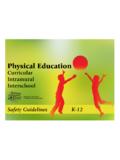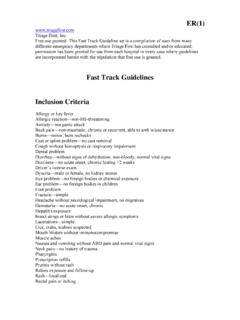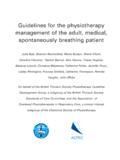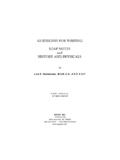Transcription of GUIDELINES FOR SCUBA DIVER'S PHYSICAL …
1 J. GUIDELINES FOR SCUBA DIVER'S PHYSICAL examination . Instructions to the Physician: Recreational SCUBA (self contained underwater breathing apparatus) diving has an excellent safety record. To maintain this status it is important to screen divers for PHYSICAL deficiencies that could place them in peril in the underwater environment. The list of conditions are given to assist you in detecting conditions that put a diver at increased risk for decompression sickness (also known as: pulmonary overin- flation syndrome) with subsequent cerebral gas embolization and loss of consciousness that could lead to drowning.
2 Additionally, the diver must be able to withstand some degree of cold stress, cope with the optical effects of water, and have a reserve of PHYSICAL and mental abil- ities to deal with possible emergencies. The history, review of systems, and PHYSICAL examination should include, at a minimum, the points listed below. The list of contraindica- tions, relative and absolute, is not all inclusive. It contains the most commonly encountered medical problems only. Diagnostic studies and specialty consultations should be obtained as indicated to satisfy the physician as to the DIVER'S status.
3 Physicians at the Divers Alert Net- work (DAN), based in the US, are available for consultation by phone +1(919) 684-2948 during normal business hours. Some conditions are absolute contraindications to SCUBA diving. Conditions that are absolute contraindications place the diver at increased risk for injury or death. Others are relative contraindications to SCUBA that may be resolved with time and proper medical intervention. Ultimately the physician should decide with the individual, based on his knowledge of the patient's medical status, whether the individual is physically qualified to participate in SCUBA diving.
4 CARDIOVASCULAR SYSTEMS. Relative Contraindications: The diagnoses listed below potentially render the diver unable to meet the exertional performance requirements likely to be encountered in recreational diving. The diagnoses listed may lead the diver to experience cardiac ischemia and its conse- quences. Formalized stress testing is encouraged if there is any doubt regarding PHYSICAL performance capability. The suggested minimum criteria for stress testing in such cases is 13 Metabolic Equivalent Units (METS). Failure to meet the exercise criteria is disqualifying.
5 Con- ditioning and retesting may make later qualification possible. History of Coronary Artery Bipass Graft (CABG) or Percutaneous Transluminal Coronary Angioplasty (PCTA) for Coronary Artery Disease (CAD). History of myocardial infarction Hypertension History of dysrythmias requiring medication for suppression Valvular regurgitation Asymptomatic mitral valve prolapse Pacemakers: The pathologic process that necessitated pacing should be addressed regarding the fitness to dive. Finally, in those instances where the problem necessitating pacing does not preclude diving, will the diver be able to meet the performance criteria?
6 Note: Pacemakers must be certified by the manufacturer as able to withstand the pressure changes involved in recre- ational diving (to depths of 130 feet of sea water). Absolute Contraindications: Venous gas emboli produced during decompression may cross intracardiac shunts and enter the cerebral circu- lation with potentially catastrophic results. Asymetric septal hypertrophy and valvular stenosis may lead to the sudden onset of unconscious- ness during exercise. Congestive heart failure PULMONARY. Any process or lesion that impedes air flow from the lung places the diver at risk for pulmonary overinflation with alveolar rupture and the possibility of cerebral air embolization.
7 Asthma (reactive airway disease), Chronic Obstructive Pulmonary Disease (COPD) cystic or cavitat- ing lung diseases all may lead to air trapping. Spirometery, provocative tests such as methacholine challenge and other studies to detect air trapping should be carried out to establish to the examining physician's satisfaction that the diver is not at risk. A pneumothorax that occurs or recurs while diving is catastrophic. As the diver ascends, air trapped in the cavity expands rapidly producing a tension pneumothorax. Relative Contraindications: History of prior asthma or Reactive Airway Disease (RAD)*.
8 History of Exercise/cold Induced Bronchospasm (EIB)*. History of solid, cystic, or cavitating lesion*. Pneumothorax secondary to: thoracic surgery,* trauma or pleural penetration,* previous overinflation injury*. Restrictive Disease**. *Air Trapping must be excluded, **Exercise Testing necessary Absolute Contraindications: Active RAD (asthma), EIB, COPD, or history of the same with abnormal Pulmonary Function Tests (PFT's) or positive challenge Restrictive diseases with exercise impairment History of spontaneous pneumothorax NEUROLOGICAL. Neurologic abnormalities that affect a DIVER'S ability to perform exercise should be assessed individually based on the degree of compromise involved.
9 Relative Contraindications: Migraine headaches whose symptoms or severity impair motor or cognitive function History of head injury with sequelae other than seizure Herniated nucleus pulposus Peripheral neuropathy Trigeminal neuralgia History of spinal cord or brain injury without residual neurologic deficit History of cerebral gas embolism without residual pulmonary air trapping has been excluded Cerebral palsy in the absence of seizure activity Absolute Contraindications: Abnormalities where the level of consciousness is subject to impairment put the diver at increased risk of drowning.
10 Divers with spinal cord or brain abnormalities where perfusion is impaired are at increased risk of spinal cord or cerebral decompression sickness. History of seizures other than childhood febrile seizures Intracranial tumor or aneurysm History of Transient Ischemic Attack (TIA) or Cerebral Vascular Accident (CVA). History of spinal cord injury, disease, or surgery with residual sequelae History of Type II (serious and/or central nervous system) decompression sickness with permanent neurologic deficits OTOLARYNGOLOGICAL. Equalization of pressure must take place during ascent and descent between ambient water pressure and the external auditory canal, middle ear, and paranasal sinuses.









